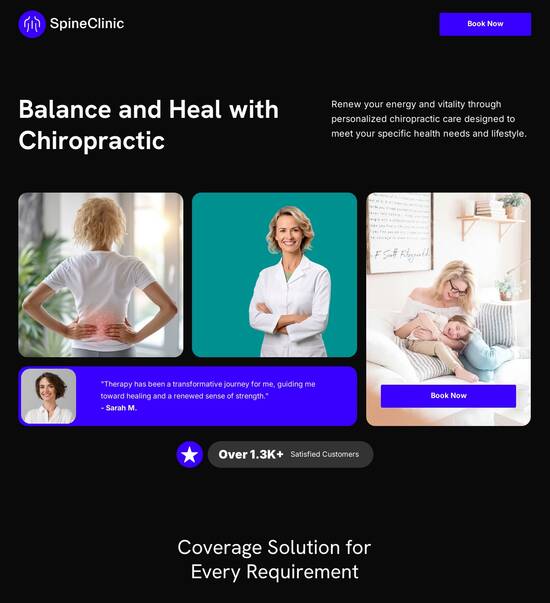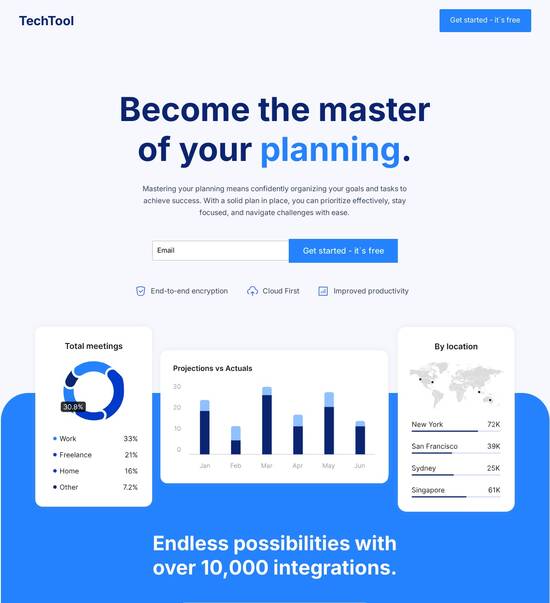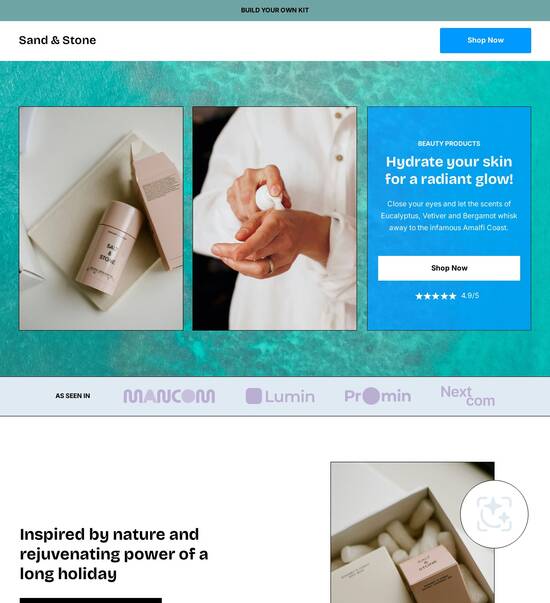
Next.js optimized lead capture page templates
Explore Similar TemplatesAbout template
Make the most with Next.js optimized lead capture page templates. Drive your success today.
Recommended templates

Easy to build without coding
With the intuitive drag-and-drop builder, anyone on your team can create high-converting pages without any knowledge of code or design. Make enhancements to your landing page with custom widgets using Javascript, HTML/CSS, or third-party scripts.

Multiple layouts for any industry and goal
Select from 500+ landing page layouts built to boost conversions across industry-specific scenarios. Customize them by adjusting fonts, adding images, and generating on-brand content with the AI assistant. Quickly scale with Instablocks® and Global Blocks that you can save, reuse, and update globally.

Loads fast and looks polished on any device
Every template is responsive, which means they present professionally on any device and load blazingly fast with our Thor Render Engine. You can also power them up with Google AMP technology to deliver an unparalleled mobile experience and drive higher conversions.

Robust analytics & experimentation
Get real-time updates and reporting across all your devices, showing the number of visitors, conversions, cost-per-visitor, and cost-per-lead. Launch AI-powered experiments, run A/B tests, and use heatmaps to analyze user behavior, then optimize your landing page to maximize conversions.







Easy to build without coding
With the intuitive drag-and-drop builder, anyone on your team can create high-converting pages without any knowledge of code or design. Make enhancements to your landing page with custom widgets using Javascript, HTML/CSS, or third-party scripts.
Multiple layouts for any industry and goal
Select from 500+ landing page layouts built to boost conversions across industry-specific scenarios. Customize them by adjusting fonts, adding images, and generating on-brand content with the AI assistant. Quickly scale with Instablocks® and Global Blocks that you can save, reuse, and update globally.
Loads fast and looks polished on any device
Every template is responsive, which means they present professionally on any device and load blazingly fast with our Thor Render Engine.
Robust analytics & experimentation
Get real-time updates and reporting across all your devices, showing the number of visitors, conversions, cost-per-visitor, and cost-per-lead. Launch AI-powered experiments, run A/B tests, and use heatmaps to analyze user behavior, then optimize your landing page to maximize conversions.
All the features you need to build free lead capture page template
Explore more featuresLearn how to build next js landing page
Frequently asked questions about next js ai template
Leading the way in building high-performing landing pages





Nextjs business template: Your ultimate how-to guide
Creating effective lead capture pages is essential for maximizing your digital marketing efforts. Instapage offers a robust platform tailored to build and optimize landing pages that not only capture leads but also enhance conversion rates. Leveraging the Next.js optimized lead capture page template enables marketers to streamline their campaigns and engage with audiences more effectively.
Understanding the Next.js optimized lead capture page template
The Next.js optimized lead capture page template is designed for speed and performance. This template leverages JavaScript capabilities, allowing for a faster user experience and higher conversion rates. By utilizing server-side rendering, you can enhance SEO optimization, making your landing pages the perfect tool for lead generation.
- High performance: Next.js allows the pages to load faster, improving the user experience and reducing bounce rates.
- SEO friendly: The structure and rendering of Next.js pages enhance their visibility on search engines, driving organic traffic.
- Seamless integration: Easily integrate with your existing tools, enabling better data tracking and analytics.
Step 1: Choose a ready-made Next.js template
Instapage provides over 100 high-converting templates, including those optimized for Next.js. Start by selecting a template that aligns with your marketing objectives, allowing you to customize it to fit your brand’s identity and campaign requirements.
Step 2: Customize your lead capture elements
Once you select your template, focus on adding lead generation elements such as forms, CTAs, and value propositions. These elements should resonate with your target audience's needs and preferences.
- Dynamic forms: Create forms that adjust based on visitor behaviors to improve lead capture.
- Engaging CTAs: Use strong, action-oriented language to encourage clicks.
- Promotional content: Highlight offers and benefits that attract visitors.
Step 3: Optimize and test your landing page
Optimization is key to ensuring your landing page meets performance benchmarks. Utilize A/B testing features on Instapage to continuously refine your landing page based on real user data.
- Heatmaps: Use heatmaps to analyze where users spend the most time and adjust content accordingly.
- A/B testing: Test different versions of your landing page to determine the most effective layout and content.
- Analytics tracking: Monitor key metrics directly within Instapage to evaluate engagement and conversion success.
By following these steps, marketers can effectively utilize the Next.js optimized lead capture page template to create high-performing landing pages.
Ready to transform your marketing campaigns? Start with Instapage and take advantage of our Next.js optimized lead capture templates to elevate your lead generation strategies.
People also ask about next js layout vs template
Next.js optimized lead capture page template
Understanding Next.js and its relevance for lead capture pages
Next.js is a powerful React framework that enables developers to create fast and efficient web applications. With features like server-side rendering, static site generation, and API routes, it simplifies complex development tasks while optimizing application performance. This makes Next.js a perfect choice for building lead capture pages where speed and user experience are critical.
What sets Next.js apart from other frameworks is its hybrid approach. Developers can choose from different rendering modes depending on their needs, offering flexibility in how pages are served. Additionally, its built-in routing system makes it easy to create clean, manageable URLs, which is essential for maximizing conversion rates on landing pages.
Lead capture pages play a pivotal role in digital marketing strategies, serving as the first point of contact between potential customers and businesses. A well-optimized lead capture page not only attracts visitors but also captures their information effectively, turning them into prospective leads. These pages can significantly impact conversion rates by offering targeted content and straightforward calls to action.
The ability to serve pre-rendered content quickly enhances user experience.
SEO advantages through optimized pages for better search visibility.
Seamless API integration for real-time data collection.
Key components of a Next.js optimized lead capture page template
For a highly functional lead capture page, it is essential to integrate key components that enhance user interaction and streamline data collection. Dynamic content rendering is a crucial aspect facilitated by Next.js. By utilizing server-side rendering (SSR), pages load faster, leading to improved user experience and better SEO rankings. This optimized loading time can be the difference between a visitor staying on your page or bouncing away.
Next.js’s reusable components architecture allows developers to create interactive UI elements that are modular and easy to maintain. For example, forms, buttons, and visuals can be designed as independent components that can be reused across multiple pages. This not only speeds up development but also ensures consistency in design and functionality.
The integration with external APIs and services enables dynamic lead data capture, allowing businesses to connect with CRMs, email marketing platforms, and analytical tools seamlessly. This ensures that every lead captured is analyzed in real-time, enhancing the ability to respond quickly and effectively to potential customers.
Dynamic content loading for a responsive user experience.
Modular components for efficient UI management.
Integration with tools like HubSpot or Google Analytics.
Designing an engaging user experience
A user-centric design is imperative for effective lead capture. UX plays a significant role in the conversion rates of landing pages. By utilizing design principles focused on the user journey, marketers can create intuitive layouts that guide visitors toward submitting their information. This includes employing familiar navigation patterns, ensuring that forms are straightforward, and highlighting calls to action with contrasting colors.
Mobile responsiveness is another key consideration. With a significant percentage of users accessing websites on mobile devices, it is essential that landing pages are optimized for smaller screens. Strategies like responsive design, flexible images, and searchable content ensure that elements fit seamlessly across various devices. This optimization can drastically impact lead generation, as mobile users are less likely to fill out forms on difficult-to-navigate pages.
Finally, loading speed is critical for retaining users. Studies show that even a one-second delay can lead to a significant drop in conversions. Next.js provides built-in features for performance optimization, such as image optimization, code splitting, and automatic server-side caching. These optimizations play a vital role in keeping users engaged and improving the overall conversion rate.
Prioritize form usability by minimizing fields.
Use clear and concise headlines that communicate value.
Ensure fast loading times through optimization features.
Developing a startup landing page template with Next.js
Creating an effective startup landing page with Next.js involves outlining essential elements that resonate with your target audience. Important components include a compelling headline, a clear value proposition, and a lead capture form that is easy to fill out. Including testimonials or case studies can provide social proof that enhances credibility and encourages visitors to engage.
To start, one must set up a new Next.js project. This can be done quickly using the create-next-app command. Following setup, the project directory should be structured carefully. Creating separate directories for components, pages, and styles helps keep the code organized and manageable.
When it comes to coding, building the landing page requires a blend of HTML, CSS, and JavaScript. For better readability and maintainability, every section of the page should be broken down into React components. Here’s a simple code snippet to illustrate how one might create a lead capture form:
for user input collection.
Styled components for consistent design.
Responsive layouts to cater to different devices.
Styling components for impactful visuals
Styling in Next.js can be managed through CSS-in-JS libraries like Styled Components, allowing developers to encapsulate styles within components. This promotes modularity and reduces style conflicts that may arise in larger applications. When choosing color schemes, typography, and imagery, the goal should be to reflect the brand's identity while appealing to the target audience.
Incorporating animations can also significantly enhance user engagement. Simple animations, when implemented judicially, can draw attention to essential elements like call-to-action buttons or lead forms. However, it’s vital to avoid over-complicating the design with excessive animations, as this can lead to a distracting experience that detracts from the primary goal.
Utilize a color palette that aligns with your brand theme.
Select fonts that enhance readability and appeal.
Use animations sparingly to highlight key actions.
Enhancing lead capture with advanced features
Incorporating A/B testing mechanisms can elevate lead capture effectiveness significantly. By experimenting with different templates, headlines, and button placements, marketers can uncover strategies that yield the highest conversion rates. Tools like Google Optimize or Optimizely can be integrated into Next.js applications to seamlessly run these tests, allowing for data-driven decision-making.
Using analytics and tracking tools further enhances lead capture efforts. Integrating platforms like Google Analytics or Hotjar enables marketers to monitor user interactions and behavior on the landing page. By analyzing KPIs such as bounce rate and conversion rate, businesses can adjust their strategies based on insights gathered from data, ultimately refining their lead capture process.
Effective forms and calls to action (CTAs) are also pivotal for lead conversion. Forms should be designed to be as straightforward as possible, consisting of essential fields that capture user information without overwhelming visitors. Attention-grabbing CTAs should be strategically placed throughout the page, made visually distinct to increase the likelihood of clicks.
Test variations of forms to identify the most effective design.
Establish clear metrics to measure performance.
Focus on minimalist designs for forms to reduce friction.
Addressing common challenges in lead capture page development
While developing lead capture pages, it's essential to be aware of potential pitfalls and find proactive solutions. Common mistakes include over-complicated designs, unclear messaging, and failure to optimize for various devices. These issues can lead to frustrations for users and ultimately diminish conversion rates. Ensuring that each element serves a clear purpose is vital for success.
Consistency across various campaigns is also key in establishing brand trust and recognition. Disparities in messaging, design, or user experience can confuse potential leads and erode confidence in your brand. To maintain uniformity, set clear guidelines that govern all marketing materials, ensuring that every campaign aligns with the overarching brand narrative.
Simplify designs for better user understanding.
Ensure consistent messaging across platforms.
Incorporate user feedback to identify pain points.
Future trends in lead capture pages and Next.js
Looking ahead, the future of lead capture pages will likely be influenced by emerging technologies and practices. Innovations in web development could lead to more interactive and personalized experiences. Factors such as voice search optimization, enhanced AI capabilities for customized user experiences, and the adoption of progressive web app (PWA) technology will shape how lead generation strategies evolve.
Next.js, in particular, will continue to evolve to embrace these trends. The addition of features that support advanced user behavioral analysis, such as machine learning-driven personalization, can further enhance the effectiveness of lead capture pages. Providing tailored content that meets user needs will likely boost conversion rates significantly.
Artificial intelligence will play a significant role in this transformation. By utilizing AI for data analysis and segmentation, businesses can craft more targeted landing pages that speak directly to user preferences. Personalized user experiences driven by AI can lead to higher engagement rates, ultimately improving conversion metrics.
Exploit machine learning for enhanced user targeting.
Prepare for increased PWA adoption for seamless user experiences.
Adapt AI capabilities for personalized content delivery.
Real-world success stories
Analyzing success stories of startups that have effectively utilized Next.js can provide valuable insights into best practices for crafting lead capture pages. For example, a tech startup enhanced its lead generation process by utilizing dynamic content features in Next.js, resulting in a 30% increase in conversion rates within just a few months. They aligned their marketing message closely with user expectations, ensuring that the offer presented resonated well with their target audience.
Expert feedback from designers and developers using Next.js for landing pages often highlights the framework’s versatility and ease of use. Many note the challenges they faced in the early stages, such as learning curve and debugging. However, these experiences also serve as lessons in effectively leveraging the capabilities of Next.js, leading to improved designs and successful campaign outcomes.
Evaluate leading strategies from case studies.
Gather feedback from experts in the field.
Apply insights to improve existing lead capture efforts.
Envisioning the future of lead capture pages with Next.js
Investing in innovative features as part of lead capture strategies will be critical for businesses seeking to maintain a competitive edge. Technologies like augmented reality and interactive content elements are on the horizon and could transform how users interact with landing pages. Next.js's architecture positions it well to integrate such advancements, enabling developers to stay ahead of user expectations.
Overall, a commitment to evolving lead capture strategies in line with technological trends will ensure their efforts remain effective and compelling. Embracing scalable solutions through tools and frameworks like Next.js empowers marketers to adapt and refine their lead generation strategies to meet the ever-changing landscapes of consumer engagement.
Stay updated on emerging technologies for web development.
Focus on scalability and adaptability in designs.
Integrate user feedback for continuous improvement.
Ready to skyrocket conversions?
Supercharge your ad campaigns with high-performing landing pages
Get started














